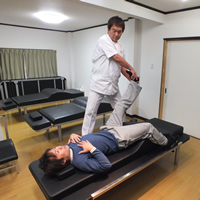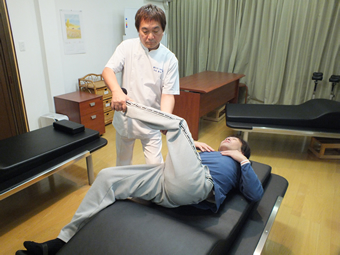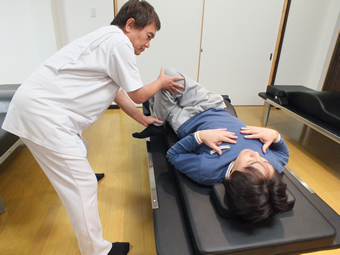

General consideration I


- Symptom
- The characteristics of lower back pains of these athletes are that you cannot name a typical symptom. Lower back pains of a judo player depends largely on the player's favorite move. Lower back pains of a player good at shoulder throw are often caused by an inflammation at the intersecting part of the iliocostalis lumborum muscle in the shallow layer of the erector muscle of spine and the obliquus muscles at the deep layer of the erector muscles of spine. A heavy-weight fighter receives a strong impact on bones when being thrown, so that often develops a spondylolysis at the lower back.
- Tamatare Remedy
- Tamatare Remedy effectively stretches the deeper layer of the muscle group that is causing the pain so as to recover their metabolism efficiency. Tamatare Remedy also resolves the problems of the body axis in three different directions: the vertical direction—the erector muscle group of spine, the horizontal direction—the side-bending muscle group, and the skew direction—the abductor muscles of lower back. These remedies cure the lower back pain.
- Details
- A judo player knows ukemi (the art of falling safely) well, so that they can dodge the impact on muscles. However, the nature of judo fights does not allow the bones to stay immune to repeated impacts received during judo fights. Since a bone does not have nerves inside, it does ache even if it is injured by a strong impact. In other words, the person does not feel anything wrong. However, the injury unfailingly develops and eventually forms a crack. A crack causes an abnormality in the muscle. The part most sensitive to a one-side disjunction is the gluteus medius muscle of the abductor muscle at the lower back. A patient always feels something wrong in that part. In the case of a both-side disjunction, the patient feels continuing lassitude or a sharp pain at times.
This disjunctive lower back pain suddenly intensifies, and the patient becomes almost unable to move. The type of lower back pain differs depending on the judo technique often used. Sweeping hip throw tends to cause stress on the side-bending muscles at the lower back on the side that exercises the technique. Spring hip throw causes stress on the adductor muscles at the lower back on the side of the pivoting foot.
Lower back pains of track and field athletes are mostly found in those who participate in throwing events. Running events do not cause lower back pains very often except when the athlete practices the start too much. Throwing events have their own characteristics in the cause of lower back pains. In a throwing event, the athlete cannot go outside the circle defined for the event, so the athlete vigorously exerts, at moment of release, the force of the antagonist muscle to suppress the muscle tension (muscle power) generated for the throw. This strong suppressing momentum helps to throw the object farther, but at the same time causes the lower back pain characteristic of this type athletic event. Sports lower back pains are usually caused by excess acceleration of muscle, while in this type of athletic event, they are caused by excess suppression force.



General consideration III








